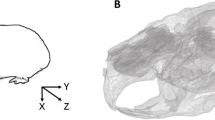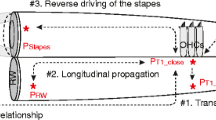Abstract
Laser interferometry was used to measure umbo velocity in the developing BALB/c mouse middle ear at 133 pure-tone frequencies between 2.0 kHz and 40.0 kHz, all at a constant 100 dB sound pressure level. Umbo velocities increased with age across the entire frequency range, and reached adult-like levels by about 19 days between 2.0 and 22.0 kHz. Velocities at 28.0 and 34.0 kHz took 27 and 52 days respectively to reach adult-like levels.
A simple middle-ear model utilizing compliance, resistance, and inertia elements matched the general trends of our velocity results and provided an indication of the anatomical basis for the growth in umbo velocity. The model suggested that velocity development at the lowest frequencies may be attributed to increases in tympanic membrane compliance. The model also indicated that both the frictional resistance of the middle ear and the inertia of the tympanic membrane and ossicles decreased during the growth period.
At frequencies below 20.0 kHz, age-related increases in umbo velocity coincided with improvements in Nj1 thresholds recorded from the round window and evoked potential thresholds obtained from the cochlear nucleus. These results indicated that the functional development of the middle-ear plays a major role in the development of hearing in the mouse.
Similar content being viewed by others
References
Cohen YE, Rubin DM, Saunders JC (1992a) Middle-ear development. I: Extra-stapedius response in the neonatal chick. Hearing Res 58:1–8
Cohen YE, Hernandez HN, Saunders JC (1992b) Middle-ear development: II. Morphometric changes in the conducting apparatus of the chick. J Morphol 212:257–267
Cohen YE, Bacon CK, Saunders JC (1992c) Middle-ear development III: Morphometric changes in the conducting apparatus of the Mongolian gerbil. Hearing Res 62:187–193
Cohen YE, Doan DE, Rubin DM, Saunders JC (1993) Middle-ear development V: Development of umbo sensitivity in the gerbil. Am J Otol (in press)
Decraemer WF, Khanna SM, Funnell WRJ (1989) Interferometric measurement of the amplitude and phase of tympanic membrane in cat. Hearing Res 38:1–18
Decraemer WF, Khanna SM, Funnell WRJ (1990) Heterodyne interferometer measurements of the frequency response of the manubrium tip in cat. Hearing Res 47:205–218
Fleischer G (1978) Evolutionary principles of the mammalian middle ear. Adv Anat Embryol Cell Biol 55:1–70
Fletcher NH (1992) Acoustic systems in biology. Oxford University Press, New York
Guinan JJ, Peake WT (1967) Middle-ear characteristics of anesthetized cats. J Acoust Soc Am 41:1237–1261
Gummer AW, Smolders JWT, Klinke R (1989) Mechanics of a single-ossicle ear: I. The extra-stapedius of the pigeon. Hearing Res 39:1–14
Huangfu M, Saunders JC (1983) Auditory development in the mouse: structural maturation of the middle ear. J Morphol 176:249–259
Magnuson B, Falk B (1988) Physiology of the eustachian tube and middle ear pressure regulation. In: Jahn AF, Santos-Sacchi J (eds) Physiology of the ear. Raven Press, New York, pp 81–102
Manley GA, Irvine DRF, Johnstone BM (1972) Frequency response of bat tympanic membrane. Nature (London) 237:112–113
Mikaelian DO (1979) Development and degeneration of hearing in the C57/b16 mouse: relation of electrophysiologic responses from the round window and cochlear nucleus to cochlear anatomy and behavioral responses. Laryngoscope 89:1–15
Relkin EM (1988) Introduction to the analysis of middle-ear function. In: Jahn AF, Santos-Sacchi J (eds) Physiology of the ear. Raven Press, New York, pp 103–124
Relkin EM, Saunders JC (1980) Displacement of the malleus in neonatal golden hamsters. Acta Otolaryngol 90:6–15
Relkin EM, Saunders JC, Konkle DF (1979) The development of middle-ear admittance in the hamster. J Acoust Soc Am 66:133–139
Saunders JC, Summers RM (1982) Auditory structure and function in the mouse middle ear: an evaluation by SEM and capacitive probe. J Comp Physiol 146:517–525
Saunders JC, Dolgin KG, Lowry LD (1980) The maturation of frequency selectivity in C57BL/6J mice studied with auditory evoked response tuning curves. Brain Res 187:69–79
Shnerson A, Pujol R (1982) Age-related changes in the C57BL/6J mouse cochlea. I. Physiological findings. Dev Brain Res 2:65–75
Shnerson A, Willott JF (1979) Development of inferior colliculus response properties in C57BL/6J mouse pups. Exp Brain Res 37:373–385
Author information
Authors and Affiliations
Rights and permissions
About this article
Cite this article
Doan, D.E., Cohen, Y.E. & Saunders, J.C. Middle-ear development. J Comp Physiol A 174, 103–110 (1994). https://doi.org/10.1007/BF00192011
Accepted:
Issue Date:
DOI: https://doi.org/10.1007/BF00192011




